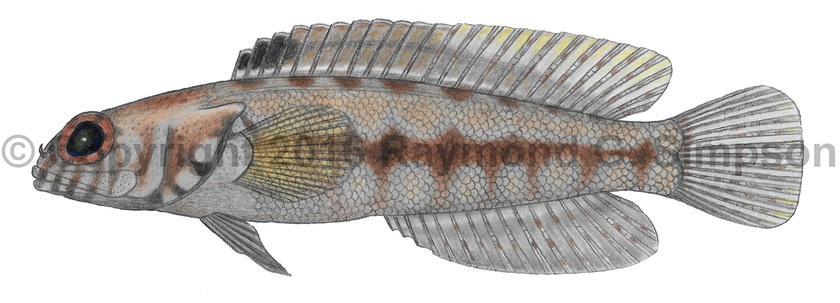
Common Name
Dusky Jawfish
Year Described
Longley, 1927
Identification
Dorsal Fin: X-XII, 13-15
Anal Fin: III, 12-14
Pelvic Fin: I, 5
Pectoral Fin: 17-20
Gill Rakers: 28-34 (total)
Vertebrae: 10 precaudal, 16-18 caudal; 26-28 total
Maxilla of males without thin, flexible posterior extension. Jaws large; reaching well past rear margin of orbit. Premaxillary and dentary with teeth. Vomer with 1-2 teeth. Lateral line extends posteriorly to between 1st and 4th segmented dorsal ray. Nape, head, pectoral base, and anterior area above lateral line scaleless. Rest of body fully scaled, including posterior area above lateral line. Lateral scale rows: 42-54. Dorsal fin spines slender with sharp, flexible tips. Anterior nostril with a short cirrus.
Color
Body whitish basally with several diffuse brown blotches on side forming a broken stripe. Ventral brown extensions of these blotches create white blotches on the lower body. Scales with pale centers or random dark spots. A series of evenly spaced dark brown blotches on dorsum continue as diffuse bands on dorsal fin. Head whitish with dark bands and brown speckles. Lips with a few brown bands and a conspicuous dark band at level behind orbit. Eye reddish with a green pupil. A dark blue spot between dorsal spines 2 and 5. Small alternating dark and pale spots on dorsal fin. Caudal fin whitish with many dark spots forming bands.
Size
Adults range from 19-66mm SL.
Habitat
A shallow dwelling jawfish, found between 0-61m (usually <20m).
Range
Southern Florida to northern South America, including the Caribbean islands.
References
Smith-Vaniz, W. F. 1997. Five new species of jawfishes (Opistognathus: Opistognathidae) from the western Atlantic Ocean. Bulletin of Marine Science v. 60 (3): 1074-1128.